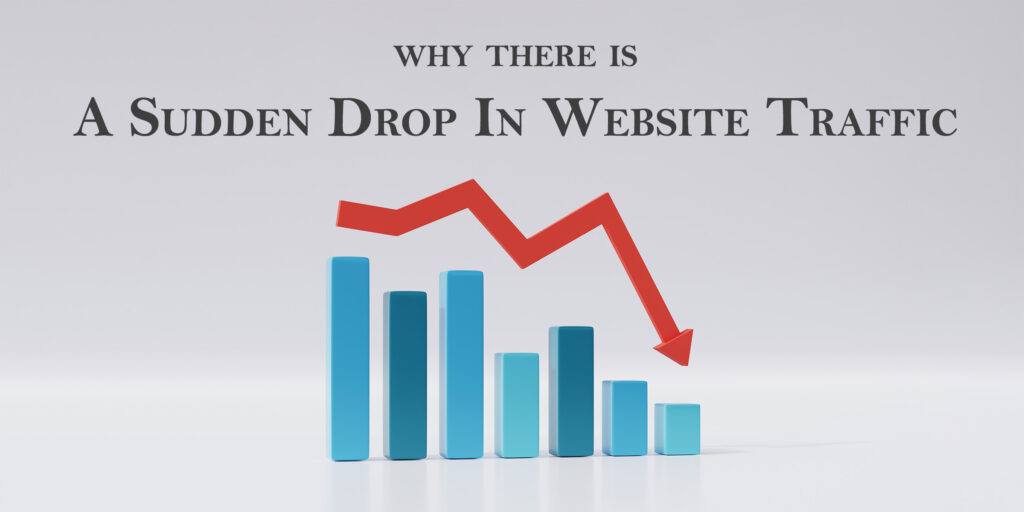The digital landscape in 2023 is dynamic and constantly evolving, with websites serving as vital tools for businesses and individuals to connect with their target audience. However, one of the most frustrating experiences for website owners in 2023 is the sudden and unexplained drop in traffic and impressions. When this happens, it can be a cause for concern, leading to questions about what went wrong and how to rectify the situation.
We will delve into the various factors that can contribute to a sudden drop in website traffic and impressions. Understanding these factors is essential for website owners, as it can help them diagnose the problem and take appropriate measures to recover their lost audience.
1. Algorithm Updates
One of the most common reasons for a sudden drop in website traffic and impressions is algorithm updates by search engines and social media platforms. Major search engines like Google are known for frequently updating their algorithms to improve the quality of search results. These updates can significantly impact a website’s search engine ranking and visibility.
When a search engine rolls out a new algorithm update, websites that were previously ranking well may find themselves lower in the search results. This can lead to a decrease in organic traffic, as users are less likely to click on results that appear further down the page. Similarly, social media platforms like Facebook and Twitter also tweak their algorithms, which can affect the visibility of your content to your followers.
To mitigate the impact of algorithm updates, website owners should stay informed about changes in search engine and social media algorithms. Additionally, they should focus on creating high-quality, relevant content that aligns with these updates’ goals. Regularly updating and optimizing your website can also help maintain or improve your search engine rankings.
2. Technical Issues
Technical issues can have a profound impact on website traffic and impressions. A sudden drop in performance, such as slow loading times, server downtime, or broken links, can deter visitors and lead to a decline in search engine rankings.
Website speed is a critical factor in user experience and search engine optimization. Users expect websites to load quickly, and search engines like Google consider page speed when ranking websites. If your website experiences slowdowns or downtime due to technical issues, it can result in decreased traffic and impressions.
To address technical issues, website owners should regularly monitor their website’s performance and address any problems promptly. This includes optimizing images and scripts, using content delivery networks (CDNs), and ensuring that your hosting provider offers reliable service.
3. Content Quality and Relevance
The quality and relevance of your website’s content play a crucial role in attracting and retaining visitors. If your content is outdated, irrelevant, or of poor quality, it can lead to a decline in traffic and impressions.
Users visit websites to find valuable information, solutions to their problems, or entertaining content. If your website fails to deliver on these expectations, visitors are less likely to engage with your content or return for future visits. This can result in a drop in traffic and impressions over time.
To maintain and improve your website’s traffic and impressions, focus on creating high-quality, relevant content that addresses your target audience’s needs and interests. Conduct keyword research to understand what topics are trending in your niche and optimize your content accordingly. Regularly update your content to ensure its accuracy and freshness.
4. Competition
The online landscape in 2023 is highly competitive, with countless websites vying for the attention of the same target audience. A sudden drop in traffic and impressions may be the result of increased competition in your niche.
New competitors entering the market, established competitors improving their online presence, or changes in consumer preferences can all impact your website’s performance. As competition intensifies, it may become more challenging to maintain or grow your share of the audience.
To stay competitive in 2023, monitor your competitors’ strategies and adapt as needed. Identify what sets your website apart and highlight those unique qualities to attract and retain visitors. Additionally, consider exploring new channels or niches to diversify your online presence.
5. Seasonal Variations
Certain industries and websites experience seasonal fluctuations in traffic and impressions. For example, e-commerce websites often see increased traffic during the holiday shopping season, while travel websites may experience peaks during vacation planning periods.
Understanding these seasonal patterns is crucial for website owners, as they can help explain sudden drops in traffic and impressions that are within the expected range. To address these variations, plan your content and marketing strategies accordingly. During slow seasons, focus on optimizing your website, creating evergreen content, and preparing for the next peak period.
6. Changes in User Behavior
User behavior on the internet is not static and can change over time. Shifts in user preferences, trends, or online habits can lead to sudden drops in website traffic and impressions.
For example, the rise of mobile devices has changed how users access and interact with websites. Websites that are not mobile-friendly may experience a decline in traffic as users prefer mobile-optimized sites. Similarly, changes in social media usage or the popularity of specific platforms can affect how users discover and engage with content.
To adapt to changing user behavior, website owners should stay informed about industry trends and emerging technologies. Ensure that your website is responsive and mobile-friendly, and adjust your content distribution strategies to align with where your target audience spends their time online.
7. Marketing and Promotion Efforts
Effective marketing and promotion efforts are essential for driving traffic and impressions to your website. A sudden drop in these metrics may be a result of changes in your marketing strategy or a decrease in promotional activities.
If you’ve reduced your marketing budget, scaled back advertising campaigns, or stopped actively promoting your website, it’s natural to see a decline in traffic and impressions. Additionally, shifts in marketing tactics or platforms can impact your website’s visibility.
To address this, evaluate your marketing and promotion efforts. Ensure that your budget and strategies align with your goals and target audience. Consider diversifying your promotional channels to reach a broader audience.
8. Penalties and Security Issues
Search engines and web browsers take website security seriously. If your website is compromised, it can result in penalties or warnings that discourage users from visiting your site. Similarly, if your website is flagged as unsafe or untrustworthy, it can lead to a drop in traffic and impressions.
Common security issues that can affect your website include malware infections, phishing attempts, and data breaches. To prevent these issues, regularly update your website’s security protocols and plugins. Implement SSL encryption to secure user data and ensure a safe browsing experience.
9. Changes in Search Engine Ranking
A sudden drop in website traffic and impressions can often be traced back to changes in search engine ranking. If your website moves from the first page of search results to a lower position or even to the second page, you are likely to see a significant decrease in organic traffic.
Several factors can impact your search engine ranking, including changes in content quality, competition, and search engine algorithm updates, as mentioned earlier. To maintain or improve your ranking, regularly optimize your website for SEO, focus on creating high-quality content, and monitor your backlink profile.

10. User Experience and Design
The user experience (UX) and design of your website play a critical role in attracting and retaining visitors. A poorly designed or difficult-to-navigate website can lead to a high bounce rate and decreased user engagement, resulting in lower traffic and impressions.
To improve the user experience, ensure that your website is easy to navigate, loads quickly, and offers a mobile-friendly design. Conduct user testing to identify any usability issues and gather feedback on your website’s design and functionality. Make necessary improvements to create a more enjoyable and user-friendly browsing experience.
11. Content Strategy
Your content strategy is a key determinant of your website’s success. If your content strategy becomes unfocused or lacks direction, it can lead to a drop in traffic and impressions.
A scattered or inconsistent content strategy may confuse your audience and make it challenging to attract and retain visitors. To address this, define clear content goals and target audience personas. Create a content calendar to plan and organize your content creation efforts, and ensure that your content aligns with your brand’s messaging and objectives.
12. External Factors
Sometimes, external factors beyond your control can contribute to a sudden drop in website traffic and impressions. These factors may include economic downturns, global events, changes in consumer behavior, or shifts in industry trends.
While you cannot control these external factors, you can adapt your strategies and messaging to respond effectively. Keep a close eye on industry trends and developments and be prepared to adjust your marketing and content strategies accordingly.
In Summary
A sudden drop in website traffic and impressions can be disheartening in 2023, but it’s crucial to approach the issue with a systematic and analytical mindset. By understanding the various factors that can contribute to such drops, website owners can diagnose the problem and take appropriate measures to recover and grow their audience.
Regularly monitoring your website’s performance, staying informed about industry trends and algorithm updates, and continuously optimizing your content and user experience are essential steps to maintaining a healthy and thriving online presence. Remember that the digital landscape is ever-changing, and adapting to these changes is key to long-term success.
For more information, visit Bel Oak Marketing.





